Czech National Bank Survey on Macroprudential and Monetary Policy: Summary of the Results
Czech National Bank Survey on
Macroprudential and Monetary Policy
Summary of the Results
June 2021
Simona Malovana´, Martin Hodula, Zuzana Rakovska´, and Josef Bajz´ik†
†All Czech National Bank. Corresponding author: Simona Malovan´a, simona.malovana@cnb.cz
Brief summary: This document presents the first summary of responses received from the Czech National Bank Survey on Macroprudential and Monetary Policy conducted in April 2021. The purpose of the survey was to collect academic and professional expert opinion on the impact of macroprudential policy measures, their interaction with monetary policy measures and the role of an institutional arrangement. A total of 361 complete responses were received, comprising experts from academia, central banks and other regulatory institutions mainly in Europe, but also in North America and other world regions.
Acknowledgement: The authors would like to thank Gene Ambrocio, Esa Jokivuolle, Jan Br°uha, Jan Frait, Libor Holub, Jana Hodulov´a, Jan Jank°u, Adam Kuˇcera and other colleagues for their invaluable comments at various stages of the survey process. The authors alone are responsible for all errors and omissions.
Disclaimer: The survey, its contents, and its potential use do not necessarily reflect the views, opinions, and intended course of action of the Czech National Bank, its management or Board.
1 Survey Description
Survey Design
In the aftermath of the Global Financial Crisis of 2007-2009, national authorities worldwide gradually introduced a number of macroprudential policy measures aimed at mitigating the systemic risk of the financial cycle. In addition to the question of the real economic impact of increasing the stringency of bank regulation, many academic and policy practitioners have examined the potential interaction between macroprudential and monetary policy. However, the design of the institutional setup for macroprudential policy has received significantly less attention.
The decision on the institutional arrangement of macroprudential and monetary policy may be crucial for the economy. In particular, we should ask whether it is desirable to have a separate macroprudential authority outside the central bank or whether it is more effective to have both institutions integrated “under one roof”. Above all, it is a matter of ensuring that there is an exchange of information between the institutions concerned. Furthermore, it is necessary to minimize the potential negative effects of a trade-off between the coordination of given policies and the credibility of an institution with multiple (and sometimes conflicting) objectives. While policy coordination can improve outcomes, concentrating multiple objectives in one institution can complicate accountability and reduce credibility.
The purpose of the survey was to collect academic and professional expert opinion on the impact of macroprudential policy measures, their interaction with monetary policy measures and the role of an institutional arrangement. By addressing both academics and experts from central banks and other institutions, the survey should be able to draw together theoretical and practical knowledge, forming a balanced view of the two. The survey focuses on three key questions. First, it examines the impact of capital-based and borrower-based measures on bank lending and the potential side effects of tightening such measures. Second, it looks at the way in which the institutional arrangement of monetary and macroprudential policy might affect the decision-making process. Third, it focuses on the ways in which monetary and macroprudential policy influence each other and how the coordination of the two policies might benefit the economy.
Given the complexity of the issues analysed, the survey questionnaire was pre-tested several times on a group of respondents with different backgrounds and expertise. As a result, some of the questions were simplified, some were removed and the order and structure of the questions were optimized. The resulting questionnaire consisted of 20 question groups which could be completed in about 15 minutes. The survey was sent to about 10,000 respondents after it was launched online on April 7, 2021. It was closed on April 31, 2021 and reminders of the deadline were sent to respondents on April 22 and April 28. We received 694 questionnaires (the response rate relative to all and deliverable email addresses was about 7% and 10% respectively), of which 361 (52%) were complete and thus included in our study.
Respondents Selection
The survey was distributed among academics and experts from central banks and other institutions, due to our desire to obtain the views of both camps. While the opinions of academics are expected to encompass all the latest research findings, the expert opinion of professionals should also draw on practical experience about the decision-making processes within the policy institution concerned.
We created a list of about 10,000 email addresses based on respondents’ expertise and affiliation (see below). We validated the email addresses beforehand using a commercially available service. About 68% of them were identified as deliverable (i.e. the email provider stated the email address existed and was safe to send emails to) and the remaining 32% were identified as risky or unknown (i.e. the quality of the email address was low or a response from the email provider was not received, i.e., the email might not be delivered).
Respondents were selected using the IDEAS/RePEc database. Our procedure comprises a number of steps. First, we decided on the researchers’ fields we wished to include.1 Overall, we included 23 relevant fields out of 98.2 We used a web scraping technique to harvest information about all the authors in each of these fields. Second, in order to include as many authors from central banks as possible, we harvested information about all the members affiliated with central banks and monetary authorities listed in the IDEAS/RePEc database.3 Third, we cleaned up this “raw list” of respondents by (i) removing the authors who had no email address, (ii) removing the authors who had not published since 2015 (i.e. had not been recently active), (iii) removing the authors with duplicate email addresses.
2 Survey Results
This document provides only a preliminary glance at the survey results. A more detailed analysis will be published as a Czech National Bank Working Paper in the second half of 2021 and will also be freely available on the Czech National Bank website.
The survey results are not meant to directly guide any policy decisions or institutional change. However, they can be used to support academic or policy discussions on the costs and benefits of different institutional arrangements. It should be noted that the objective is not to identify the best institutional framework, as country specifics will always play an important role.
Table 1 provides a brief summary of survey responses. The following figures report the basic distribution of survey responses for each question. The full questionnaire can be found in the Appendix.
Most respondents are men aged 30 to 59 from the euro area countries (about 33%), followed by men aged 30 to 59 from European, non-euro area countries (about 15%). The sample includes a fair share of respondents with both academic experience and experience from a central bank or macroprudential institution. About 70% of respondents identified themselves as researchers; the remaining 30% is evenly distributed between experts and respondents in managerial positions (heads of departments, directors, or executive directors).
Regarding the impact of macroprudential measures, most respondents stated that they expect higher capital buffers to have a negative effect on bank lending in the short-term but minimal to no effect in the long-term. On the contrary, borrower-based measures are expected to have a negative effect on the provision of housing loans in the short and long term. Most respondents also regard the higher cost of bank lending, portfolio rebalancing and distributional effects, and regulatory arbitrage and leakages as likely side effects of tighter macroprudential regulation.
Concerning the institutional arrangement, the vast majority of respondents acknowledge the significant benefits of keeping monetary and macroprudential policy “under one roof”. They perceive data/knowledge sharing and the capacity to act swiftly as having significant benefits, and informal relationships to have some benefits if the central bank conducts both monetary and macroprudential policy (as opposed to conducting monetary policy only). They also expect the stringency of macroprudential measures and financial system resilience to be somewhat higher and the provision of bank lending to remain mostly unchanged if both policies are conducted by one institution.
As regards the interaction and coordination of macroprudential and monetary policy, most respondents state that the two policies somewhat influence each other and believe that their

1https://ideas.repec.org/i/e.html
2Accounting & Auditing (NEP-ACC), Banking (NEP-BAN), Central Banking (NEP-CBA), Corporate Finance (NEPCFN), Computational Economics (NEP-CMP), Dynamic General Equilibrium (NEP-DGE),Econometrics (NEP-ECM),
European Economics (NEP-EEC), Econometric Time Series (NEP-ETS), Microeconomic European Issues (NEP-EUR), Financial Markets (NEP-FMK), Forecasting (NEP-FOR), Business, Economic & Financial History (NEP-HIS), Insurance
Economics (NEP-IAS), International Finance (NEP-IFN), Macroeconomics (NEP-MAC), Microfinance (NEP-MFD), Microeconomics (NEP-MIC), Monetary Economics (NEP-MON), Market Microstructure (NEP-MST), Open Economy
Macroeconomics (NEP-OPM), Regulation (NEP-REG), Risk Management (NEP-RMG).
3https://edirc.repec.org/central.html
coordination is very desirable. In addition, more than 36% of respondents state that financial stability should be temporarily favoured over price stability in the event of a conflict between achieving the two objectives; a further 10% state that financial stability should always be favoured. On the contrary, only about 16% of respondents state that price stability should be favoured temporarily, with 14% stating they should be favoured always. Respondents consider the different horizons of the two policies, the different length and/or depth of the business and financial cycle and the delay between the announcement and implementation of macroprudential policy measures to be likely reasons for a conflict between macroprudential and monetary policy.
In relation
to additional views from the survey, more than 50% of respondents state that a
low interest rate environment (LIRE) contributes to a build-up of financial
imbalances in both the short and the long term. Only about 9% state that a LIRE
does not contribute to a build-up of financial imbalances. About 45% of
respondents consider monetary policy measures somewhat effective in mitigating
existing systemic risks and an additional 6% consider this policy significantly
effective. However, 32% of respondents consider monetary policy measures
somewhat ineffective in this pursuit, with 16% considering them very effective.
Table 1: Survey Responses – Summary
|
No. Question Modal answer |
% share of modal answer |
No. of answer options |
No. of responses |
|||
|
Demographics and Background |
||||||
|
1 Gender Male |
86.4 |
3 |
361 |
|||
|
2 Age 30-39 |
31.3 |
5 |
361 |
|||
|
3 Region |
Europe - Euro Area |
47.1 |
6 |
361 |
||
|
4 No. of R/E fields reported |
2 |
35 |
11 |
360 |
||
|
5 Academic exp. (years) |
3 |
9.1 |
35 |
307 |
||
|
5 CB/MPP inst. exp. (years) |
2 |
9.3 |
37 |
215 |
||
|
5 Other public inst. exp. (years) |
2 |
17.2 |
23 |
93 |
||
|
5 Private sector exp. (years) |
3 |
19.3 |
22 |
88 |
||
|
5 Cumulative years of exp. |
8 |
5.3 |
62 |
360 |
||
|
6 |
Minimum CR (ST) |
Some decrease in lending |
57.9 |
6 |
361 |
|
|
6 |
Minimum CR (LT) |
Minimal to no change |
48.5 |
6 |
361 |
|
|
7 |
Capital buffer (ST) |
Some decrease in lending |
56.5 |
6 |
361 |
|
|
7 |
Capital buffer (LT) |
Minimal to no change |
42.1 |
6 |
361 |
|
|
8 |
LTV (ST) |
Some decrease in housing loans |
56.8 |
6 |
361 |
|
|
8 |
LTV (LT) |
Some decrease in housing loans |
47.1 |
6 |
361 |
|
|
8 |
DSTI (ST) |
Some decrease in housing loans |
56.8 |
6 |
361 |
|
|
8 |
DSTI (LT) |
Some decrease in housing loans |
42.9 |
6 |
361 |
|
|
9 |
Side effect: cost (CR) |
Likely |
53.7 |
5 |
361 |
|
|
9 |
Side effect: cost (BBM) |
Unlikely |
40.7 |
5 |
361 |
|
|
9 |
Side effect: rebalancing (CR) |
Likely |
54 |
5 |
361 |
|
|
9 |
Side effect: rebalancing (BBM) |
Likely |
51 |
5 |
361 |
|
|
9 |
Side effect: arbitrage (CR) |
Likely |
44.9 |
5 |
361 |
|
|
9 |
Side effect: arbitrage (BBM) |
Likely |
42.4 |
5 |
361 |
|
|
Block 2: Institutional Arrangement |
||||||
|
10 Both policies |
Yes, the benefits significantly outweigh the costs |
44.3 |
6 |
361 |
||
|
11 Benefits: knowledge sharing |
Significant benefits |
58.7 |
6 |
361 |
||
|
11 Benefits: informal relations |
Some benefits |
42.9 |
6 |
361 |
||
|
11 Benefits: capacity to act swiftly |
Significant benefits |
44.6 |
6 |
361 |
||
|
12 Different: stringency |
Somewhat higher |
39.1 |
6 |
361 |
||
|
12 Different: lending |
Minimal to no change |
41.6 |
6 |
361 |
||
|
12 Different: resilience |
Somewhat higher |
44.6 |
6 |
361 |
||
|
Block 3: Macroprudential and Monetary Policy Coordination |
||||||
|
13 Conflict of objectives Yes, financial stability, but only temporarily |
36.3 |
6 |
361 |
|||
|
14 Mutual influence Yes, somewhat |
51.4 |
4 |
360 |
|||
|
15 Coordination Yes, very |
57.8 |
4 |
360 |
|||
|
16 Conflict: time horizon Likely |
52.2 |
5 |
360 |
|||
|
16 Conflict: cycles Likely |
51.9 |
5 |
360 |
|||
|
16 Conflict: implementation delay Likely |
43.1 |
5 |
360 |
|||
|
Additional Views and Background Questions |
||||||
|
17 Perceived stringency Somewhat stringent |
47.2 |
5 |
360 |
|||
|
18 LIRE - financial imbalances Yes, in both the short and the long term |
51.1 |
5 |
360 |
|||
|
19 MP effectiveness Somewhat effective |
43.9 |
5 |
360 |
|||
|
20 Current position Researcher |
68.9 |
5 |
360 |
|||
Note: R – research; E – expert; CB/MMP – central bank/macro-prudential institution; ST – short-term; LT – long-term; CR – capital requirements; BBM – borrower-based measures; LIRE – low interest rate environment; MP – monetary policy.
Demographics and Background
Q 1: What gender do you identify as?
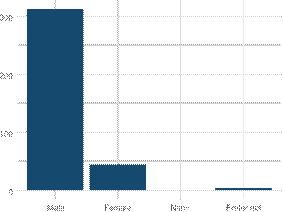
conforming to answer
Q 2: What is your age?
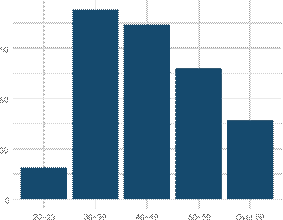
Q 3: Please indicate region in which you currently reside professionally.
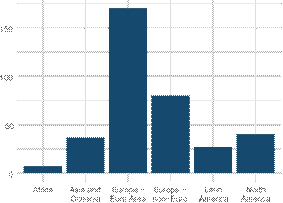
Area and the Caribbean
Q 5: Please indicate the approximate number of years of professional experience you have gained in each of the following sectors.
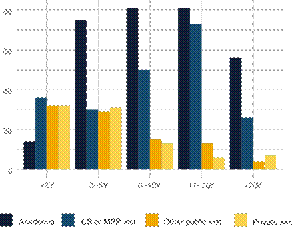
Note: CB or MPP inst. – central bank or macroprudential institution.
Q 4-I: Please indicate your primary field of research and/or expertise – no. of reported fields
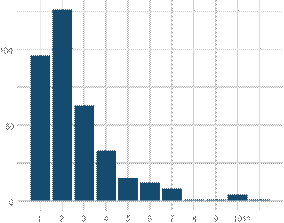
No. of reported fields
Q 4-II: Please indicate your primary field of research and/or expertise – share of reported
fields
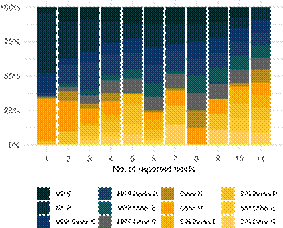
Note: E – expert; R – researcher; MP – monetary policy; MPP – macroprudential policy; S/R – supervision/regulation.
Block 1: Macroprudential Policy and Bank Lending
Q 6: What is the most likely impact of additional 2.5 percentage points of capital conservation buffer above the 8% on the provision of bank lending?
|
(a) Short-term impact (the build-up phase) |
(b) Long-term impact (until the buffer is |
 released
or used)
released
or used)
in lending in lending in lending in
lending 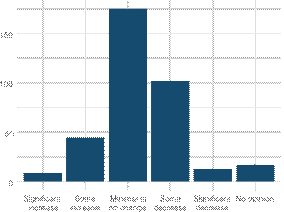
in lending in lending in lending in lending
Q 7: What is the most likely impact of additional 2.5 percentage points of any of these capital buffers above the 10.5% on the provision of bank lending?
(a) Short-term impact (the build-up phase) (b) Long-term impact (until the buffer is
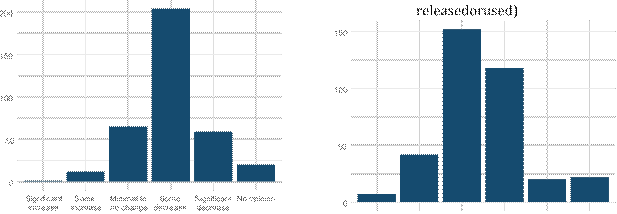
in lending in lending in lending in lending Significant Some Minimal to Some Significant No opinion
increase increase no change decrease decrease in lending in lending in lending in lending
Q 8-I: What is the most likely impact of decreasing (i.e. tightening) LTV or DSTI limits on the provision of housing loans?
|
(b) LTV: Long-term impact (until the buffer is released or used) |

|
in housing in housing loans loans |
in housing in housing loans loans |
in housing in housing loans loans |
in housing in housing loans loans |
Q 8-II: What is the most likely impact of decreasing (i.e. tightening) LTV or DSTI limits on the
provision of housing loans?
(a)
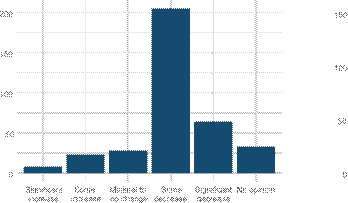 |
DSTI: Short-term impact (the build-upphase)
in housing in housing in housing in housing loans loans loans loans
(b) DSTI: Long-term impact (until the buffer isreleased or used)
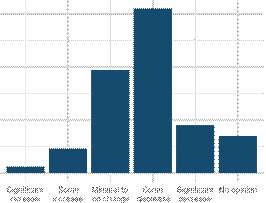
in housing in housing in housing in housing loans loans loans loans
Q 9: How likely are the following side effects of more stringent macroprudential policy measures? (a) Higher overall capital requirements
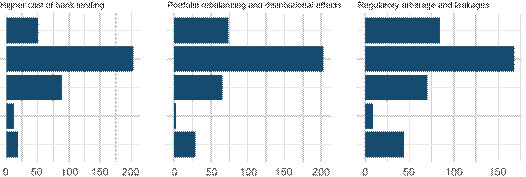 Very likely
Very likely
Likely
Unlikely
Very unlikely No opinion
(b) Lower borrower-based limits (LTV, DSTI)
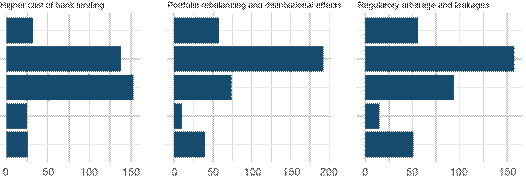 Very likely
Very likely
Likely
Unlikely
Very unlikely
No opinion
Block 2: Institutional Arrangement
Q 10: Should the central bank conduct both monetary policy and macroprudential policy?
Q 13: If there is a conflict between achieving price stability and financial stability, should a central bank favour one of the two?
 significantly somewhat somewhat
significantly
significantly somewhat somewhat
significantly 
|
outweigh the costs |
outweigh the costs |
outweigh the benefits |
outweigh the benefits |
but only stability, temporarily but only temporarily |
price stability |
financial stability |
Q 11: How are the following likely to be beneficial to the policy decision-making process if the central bank conducts both monetary and macroprudential policy (as opposed to conducting monetary policy only)?
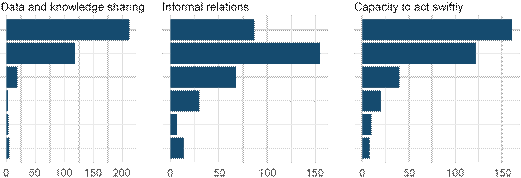 Significant benefits
Significant benefits
Some benefits Minimal to no change
Some costs
Significant costs No opinion
Q 12: How are the following likely to be different if the central bank conducts both monetary and macroprudential policy (as opposed to conducting monetary policy only)?
 Significantly higher
Significantly higher
Somewhat higher Minimal to no change
Significantly lower
Somewhat lower No opinion
Block 3: Macroprudential and Monetary Policy Coordination
Q 14: Do macroprudential policy measures and monetary policy measures influence each other?
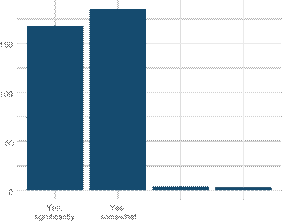 No No opinion
No No opinion
Q 15: Is the coordination of macroprudential and monetary policy desirable for the economy, regardless of the institutional arrangement?
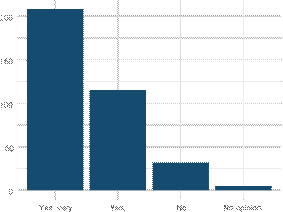
somewhat
Q 16: To what extent are the following likely to result in a conflict between macroprudential and monetary policy?

Additional Views and Background Questions
Q 17: How would you describe the overall stringency of macroprudential policy measures applied in your jurisdiction before the Covid-19 pandemic?
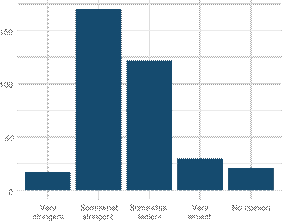
Q 18: Does a low interest rate environment contribute to a build-up of financial imbalances?
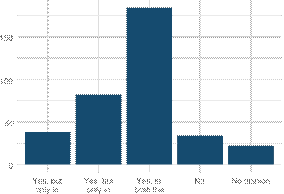
the short the long short and term term the long
term
Q 19: Do you consider monetary policy measures effective in mitigating existing systemic risks?
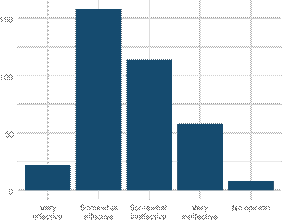
Q 20: Please indicate your current position (choose the most relevant one).
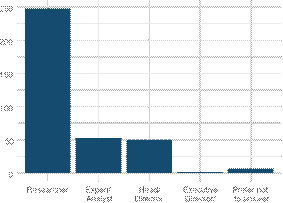
Board
Member
3 Questionnaire
We would like to invite you to participate in the Czech National Bank Survey on Macroprudential and Monetary Policy. The purpose of this survey is to collect academic and professional expert opinion on the impact of macroprudential policy measures, how they interact with monetary policy measures and the role of an institutional arrangement. The survey was designed by Czech National Bank research economists. You can find out more about our survey team and access the answers to some frequently asked questions on the survey webpage.
The survey consists of 20 questions and will take about 15 minutes to complete. The survey is anonymous and will not ask for any identifying information. Your participation is completely voluntary. You may refuse to take part in the research study or exit the survey at any time.
Please answer all the questions based on your own opinion and expertise. We understand that it may be difficult to provide answers to some questions in this survey without further qualifications. We encourage you to use the feedback section at the end of each block to expand on your answers if necessary. Your participation is essential for the success of this research study and would be greatly appreciated.
The results will be analysed and published as a Czech National Bank Working Paper. They are not meant to directly guide any policy decisions. A short summary of the results and the detailed Working Paper will be freely available on the Czech National Bank website in the next few months.
Please submit your responses by 30 April 2021.
If you have questions at any time about the survey or the research paper, or if you want to be removed from the mailing list of invited survey respondents, please contact us by email at MMPSurvey@cnb.cz.
Thank you very much for your time.
Sincerely
The Survey Team
Demographics and Background
1. What gender do you identify as?
m Male m Female
m Non-conforming
m Prefer not to answer
2. What is your age? m 20-29 m 30-39 m 40-49 m 50-59
m Over 59
3. Please indicate region in which you currently reside professionally. You may also indicate a specific country in the text box (optional).
m Africa m Asia and Oceania m Europe – Euro Area m Europe – non-Euro Area m Latin America and the Caribbean
m North America
4. Please indicate your primary field of research and/or expertise.
You can select more than one option in each row.
Researcher Expert/
Analyst
Monetary policy
Macroprudential policy – banks
Macroprudential policy – financial institutions other than banks
Regulation and supervision – banks
Regulation and supervision – financial institutions other than banks
Other
5. Please indicate the approximate number of years of professional experience you have gained in each of the following sectors.
Only numbers may be entered in these fields.
Academia
Central bank with a macroprudential policy mandate
Central bank without a macroprudential policy mandate
Regulatory, supervisory or macroprudential authority other than a central bank
Other public or international organization
Private financial sector
Private non-financial sector
Block 1: Macroprudential Policy and Bank Lending
6. Under Basel III, a bank’s overall minimum capital adequacy ratio must be at least 10.5% of its riskweighted assets (8% minimum capital requirement and 2.5% capital conservation buffer). The phase in period for the capital conservation buffer was 2016-2019.
What is the most likely impact of additional 2.5 percentage points of capital conservation buffer above the 8% on the provision of bank lending?
Please answer based on your own opinion and expertise.
Significant Some Minimal Some Significant No increase in increase in to no decrease decrease opinion
lending lending change in lending in lending
Short-term impact (the build-up phase)
Long-term impact (until the buffer is released or used)
7. Macroprudential regulators may introduce additional capital buffers above the 10.5% minimum capital adequacy ratio. In the European framework, these buffers include the countercyclical capital buffer, buffers for global and other systemically important institutions and the systemic risk buffer.
What is the most likely impact of additional 2.5 percentage points of any of these capital buffers above the 10.5% on the provision of bank lending?
Please answer based on your own opinion and expertise.
Significant Some Minimal Some Significant No increase in increase in to no decrease decrease opinion
lending lending change in lending in lending
Short-term impact (the build-up phase)
Long-term impact (until the buffer is released or used)
8. In addition to capital requirements, a macroprudential authority may set borrower-based limits, such as loan-to-value (LTV) and debt service-to-income (DSTI) limits.
What is the most likely impact of decreasing (i.e. tightening) LTV or DSTI limits on the provision of housing loans?
Please answer based on your own opinion and expertise.
a. Short-term impact (e.g. 1 year)
|
Significant increase in housing loans |
Some increase in housing loans |
Minimal to no change |
Some decrease in housing loans |
Significant decrease in housing loans |
No opinion |
b. Long-term impact (until the limit is released)
|
Significant increase in housing loans |
Some increase in housing loans |
Minimal to no change |
Some decrease in housing loans |
Significant decrease in housing loans |
No opinion |
LTV limit
DSTI limit
9. How likely are the following side effects of more stringent macroprudential policy measures?
Please answer based on your own opinion and expertise.
a. Higher overall capital requirements
Very Likely Unlikely Very No likely unlikely opinion
Portfolio rebalancing and distributional effects*
Regulatory arbitrage and leakages**
b. Lower borrower-based limits (LTV, DSTI)
Very Likely Unlikely Very No likely unlikely opinion
Portfolio rebalancing and distributional effects*
Regulatory arbitrage and leakages**
* Portfolio rebalancing effect – the redirection of funds into the desired asset allocation, reflecting a change in goals, time horizon or risk tolerance. Distributional effect – the shift in the provision of bank lending between different groups of banks and/or clients (e.g. towards banks and/or clients with different characteristics).
** Regulatory arbitrage and leakages – the structuring of activities in a way that reduces the impact of regulation without a corresponding reduction in the underlying risk and/or the shifting of activities to non-bank financial institutions.
Block 2: Institutional Arrangement
10. Should the central bank conduct both monetary policy and macroprudential policy*?
Please answer based on your own opinion and expertise.
m Yes, the benefits significantly outweigh the costs m Yes, the benefits somewhat outweigh the costs m It does not matter m No, the costs somewhat outweigh the benefits m No, the costs significantly outweigh the benefits m No opinion
* Please consider those institutional arrangements in which the central bank has a decisive role in setting macroprudential policy measures either by making its own decisions or through committees and boards.
11. How are the following likely to be beneficial to the policy decisionmaking process if the central bank conducts both monetary and macroprudential policy* (as opposed to conducting monetary policy only)?
Please answer based on your own opinion and expertise.
Significant Some Minimal Some Significant No benefits benefits to no costs costs opinion
change
Data and knowledge sharing
Informal relations
Capacity to act swiftly
* Please consider those institutional arrangements in which the central bank has a decisive role in setting macroprudential
policy measures either by making its own decisions or through committees and boards.
12. How are the following likely to be different if the central bank conducts both monetary and macroprudential policy* (as opposed to conducting monetary policy only)?
Please answer based on your own opinion and expertise.
Significantly Somewhat Minimal Somewhat Significantly No
higher higher to no lower lower opinion
change Stringency of macroprudential measures Provision of bank lending
Financial system resilience
* Please consider those institutional arrangements in which the central bank has a decisive role in setting macroprudential
policy measures either by making its own decisions or through committees and boards.
13. If there is a conflict between achieving price stability and financial stability (i.e. they cannot both be achieved at the same time), should a central bank favour one of the two?
Please answer based on your own opinion and expertise.
m Yes, price stability, but only temporarily m Yes, financial stability, but only temporarily m Yes, always price stability m Yes, always financial stability
m No
m No opinion
Block 3: Macroprudential and Monetary Policy Coordination
14. Do macroprudential policy measures and monetary policy measures influence each other?
Please answer based on your own opinion and expertise.
m Yes, significantly m Yes, somewhat
m No
m No opinion
15. Is the coordination of macroprudential and monetary policy desirable for the economy, regardless of the institutional arrangement?
Please answer based on your own opinion and expertise.
m Yes, very m Yes, somewhat
m No
m No opinion
16. To what extent are the following likely to result in a conflict between macroprudential and monetary policy?
Please answer based on your own opinion and expertise.
Very Likely Unlikely Very No likely unlikely opinion
Different horizon of both policies
Different length and/or depth of the business
and financial cycle
Delay between the announcement and implementation of macroprudential policy
measures
Additional Views and Background Questions
17. How would you describe the overall stringency of macroprudential policy measures applied in your jurisdiction before the Covid-19 pandemic?
Please answer based on your own opinion and expertise.
m Very stringent m Somewhat stringent m Somewhat lenient m Very lenient m No opinion
18. Does a low interest rate environment contribute to a build-up of financial imbalances?
Please answer based on your own opinion and expertise.
m Yes, but only in the short term m Yes, but only in the long term m Yes, in both the short and the long term
m No
m No opinion
19. Do you consider monetary policy measures effective in mitigating existing systemic risks?
Please answer based on your own opinion and expertise.
m Very effective m Somewhat effective m Somewhat ineffective m Very ineffective m No opinion
20. Please indicate your current position (choose the most relevant one).
m Researcher m Expert/Analyst m Head/Director m Executive Director/Board Member m Prefer not to answer
Thank you for participating in our survey.
The results will be analysed and published as a Czech National Bank Working Paper and will be freely available on the Czech National Bank website in the next few months.
If you have any questions or comments, or would simply like to reach out to the survey team, please do not hesitate to get in touch. We welcome any comments, suggestions and queries you might have and will get back to you as soon as we can. You can reach us at the following email address: MMPSurvey@cnb.cz.
Poslední zprávy z rubriky Makroekonomika:
Přečtěte si také:
Příbuzné stránky
- Kurzovní lístek Komerční banka, Kurzovní lístky bank
- Kurzovní lístek UniCredit Bank, Kurzovní lístky bank
- Erste Bank ve Vídni - aktuální graf akcie Erste Bank ve Vídni v bodech
- Nejbližší banka, banky v ČR
- Kódy bank - Banky v ČR
- Kurzovní lístek Fio banka, Kurzovní lístky bank
- KOMERČNÍ BANKA - Akcie KOMERČNÍ BANKA aktuálně, kurzy Burza - akcie online
- Akcie ERSTE GROUP BANK AG - ERSTE BANK, aktuální vývoj cen obchodů Burza, akcie-cz online
- MONETA MONEY BANK - Akcie MONETA MONEY BANK aktuálně, kurzy Burza - akcie online
- ERSTE GROUP BANK A - Akcie ERSTE GROUP BANK A aktuálně, kurzy Burza - akcie online
- Akcie ERSTE GROUP BANK AG - ERSTE BANK, aktuální vývoj cen, akcie-cz online
- SWIFT kódy bank - BIC kód Banky k IBAN číslu účtu
Prezentace
18.12.2024 Apple iPad je rekordně levný, vyjde teď jen na 8
17.12.2024 Začínáte s kryptoměnami? Binance je ideálním…
Okénko investora

Radoslav Jusko, Ronda Invest
AI, demografie a ženy investorky. Investiční trendy pro rok 2025

Miroslav Novák, AKCENTA
ČNB v prosinci přerušila, nikoliv však zastavila cyklus uvolňování měnové politiky

Petr Lajsek, Purple Trading

John J. Hardy, Saxo Bank
Šokující předpověď - Nvidia dosáhne dvojnásobku hodnoty Applu

Olívia Lacenová, Wonderinterest Trading Ltd.

Mgr. Timur Barotov, BHS

Ali Daylami, BITmarkets

Jakub Petruška, Zlaťáky.cz
S návratem Donalda Trumpa zlato prudce klesá. Trhy zachvátila pozitivní nálada

Jiří Cimpel, Cimpel & Partneři
Portfolio 60/40: Nadčasová strategie pro dlouhodobé investory




